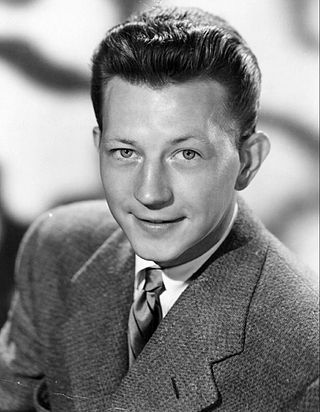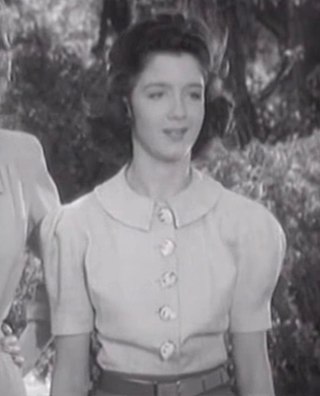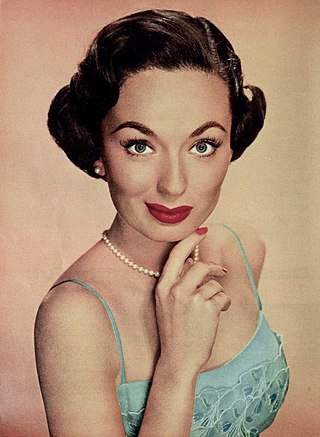
Donald David Dixon Ronald O'Connor was an American dancer, singer and actor. He came to fame in a series of films in which he co-starred with Gloria Jean, Peggy Ryan, and Francis the Talking Mule.

Margaret O'Rene Ryan was an American dancer and actress, best known for starring in a series of movie musicals at Universal Pictures with Donald O'Connor and Gloria Jean.

Ann Marie Blyth is an American retired actress and singer. For her performance as Veda in the 1945 Michael Curtiz film Mildred Pierce, Blyth was nominated for an Academy Award for Best Supporting Actress. She is one of the last surviving stars from the Golden Age of Hollywood cinema, and became the earliest living acting Academy Award nominee upon the death of Angela Lansbury in 2022.

Helen Broderick was an American actress known for her comic roles, especially as a wisecracking sidekick.
Charles Lamont was a prolific filmmaker, directing over 200 titles and producing and writing many others. He directed nine Abbott and Costello comedies and many Ma and Pa Kettle films.

Helen Vinson was an American film actress who appeared in 40 films between 1932 and 1945.

Follow the Boys also known as Three Cheers for the Boys is a 1944 musical film made by Universal Pictures during World War II as an all-star cast morale booster to entertain the troops abroad and the civilians at home. The film was directed by A. Edward "Eddie" Sutherland and produced by Charles K. Feldman. The movie stars George Raft and Vera Zorina and features Grace McDonald, Charles Grapewin, Regis Toomey and George Macready. At one point in the film, Orson Welles saws Marlene Dietrich in half during a magic show. W.C. Fields, in his first movie since 1941, performs a classic pool-playing presentation he first developed in vaudeville four decades earlier in 1903.
Private Buckaroo is a 1942 American comedy-musical film directed by Edward F. Cline starring The Andrews Sisters, Dick Foran, Harry James, Shemp Howard, Joe E. Lewis, and Jennifer Holt. The film tells the story of army recruits following basic training, with the Andrews Sisters attending USO dances.

When Johnny Comes Marching Home is a 1942 musical film directed by Charles Lamont and starring Allan Jones and Jane Frazee. The film is loosely based on the song with the same title.
Get Hep to Love is a 1942 musical film starring Gloria Jean, Donald O'Connor, Jane Frazee, Robert Paige and Peggy Ryan. The film was directed by Charles Lamont.
Joel Jay Kupperman was an American professor of philosophy at the University of Connecticut and author of Six Myths about the Good Life, a popular philosophical volume centering on those values most worth engaging in human life. He was best known to the general public as a young math expert on the radio and television show Quiz Kids. He astounded audiences with his ability to do complex mathematics rapidly and seemingly "in his head." He also had strong general knowledge, and was often the winner of the weekly competitions featured on the show. The 1944 film Chip Off the Old Block, starring Donald O'Connor, Peggy Ryan and Ann Blyth, featured Kupperman as the "Quiz Kid", representative of the group.

Swell Guy is a 1946 American drama film directed by Frank Tuttle and starring Sonny Tufts, Ann Blyth and Ruth Warwick. It was distributed by Universal Pictures. The film's screenplay by Richard Brooks is based on the 1921 play The Hero by Gilbert Emery.

It All Came True is a 1940 American musical comedy crime film starring Ann Sheridan as a fledgling singer and Humphrey Bogart, who was third-billed on movie posters, as a gangster who hides from the police in a boarding house. It is based on the Louis Bromfield novel Better Than Life. Sheridan introduced the hit song "Angel in Disguise". The picture was produced by Mark Hellinger and directed by Lewis Seiler. The cast also featured Jeffrey Lynn as the leading man, Zasu Pitts, and Una O'Connor.
Mister Big is a 1943 musical directed by Charles Lamont, starring Donald O'Connor, Gloria Jean and Peggy Ryan. The film features the song "Rude, Crude, and Unattractive".
It Comes Up Love is a 1943 American, black and white, musical comedy starring Gloria Jean, Ian Hunter, and Donald O'Connor. It is the only film starring Jean and O'Connor that doesn't also star Peggy Ryan, another one of the talented teenagers at Universal Studios.

Top Man is a 1943 American black-and-white musical comedy film directed by Charles Lamont and starring Donald O'Connor, Susanna Foster, Lillian Gish, Richard Dix, and Peggy Ryan. It was O'Connor and Ryan's first film away from the third of their trio, Gloria Jean.

The Merry Monahans is a 1944 American comedy-drama musical film directed by Charles Lamont and starring Donald O'Connor, Peggy Ryan and Jack Oakie.

Bowery to Broadway is a 1944 American film starring Maria Montez, Jack Oakie, and Susanna Foster. Donald O'Connor and Peggy Ryan also had a small specialty act, and it was the only film they were in together where they didn't have a name or character.

Babes on Swing Street is a 1944 musical comedy film directed by Edward C. Lilley and starring Ann Blyth, Peggy Ryan, and Andy Devine. It was produced by Universal Pictures.
The Jivin' Jacks and Jills were a twentieth century American dance group of the World War II era.












